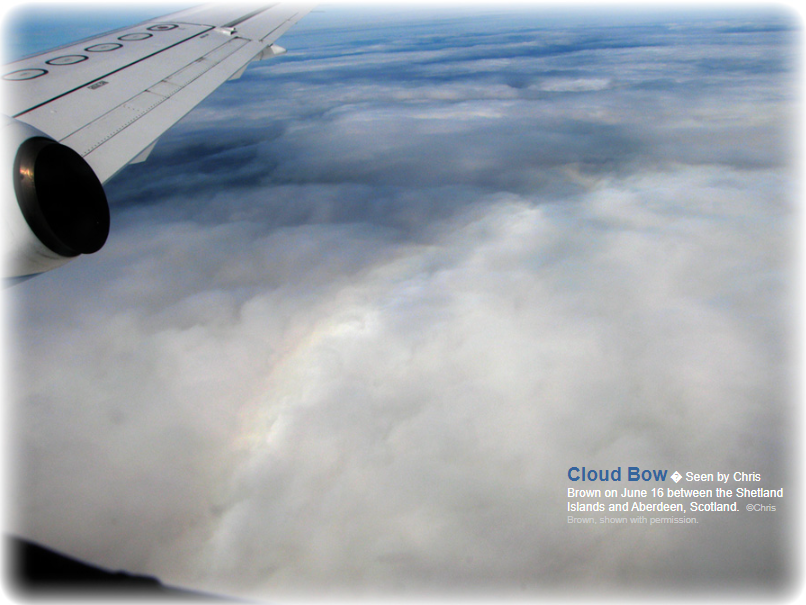Scottish Cloud Bow
The Scottish Cloud Bow: A Captivating Atmospheric Phenomenon
Have you ever witnessed a breathtaking optical display in the sky that resembles a rainbow but appears within clouds? This captivating atmospheric phenomenon is known as a cloud bow. Unlike rainbows, which typically form in raindrops, cloud bows are created by sunlight interacting with water droplets within clouds. In this article, we will delve into the intricacies of the Scottish cloud bow and explore its mesmerizing features.
Discovering the Enigmatic Cloud Bow
Cloud bows are elusive phenomena that are often overlooked due to their low contrast and pastel colors. They can appear almost colorless or exhibit subtle shades, similar to a rainbow. Despite their faint appearance, cloud bows can be easily spotted with the naked eye when they drift alongside an aircraft across a lower cloud deck. To catch a glimpse of this celestial spectacle, direct your gaze downward, opposite to the position of the sun. Sometimes, you may even witness a glory at the center of the bow, adding an extra touch of enchantment to the scene.
Unraveling the Science Behind Cloud Bows
The formation of cloud bows follows a similar principle to rainbows. When sunlight penetrates the water droplets present within clouds, it undergoes internal reflection before finally leaving the droplets. This refraction process at both entry and exit points causes the dispersion of light into its constituent colors, resulting in the appearance of a bow.
However, cloud bows possess distinct characteristics that set them apart from rainbows. They are broader in shape and exhibit more diffuse colors. This is due to an additional optical phenomenon called diffraction, which plays a significant role in their formation. Unlike raindrops, cloud droplets are significantly smaller, causing light waves to deviate from their straight paths and scatter more widely. Consequently, this diffraction effect gives rise to a more expansive and diffused appearance of the cloud bow.
The Allure of the Scottish Cloud Bow
The Scottish cloud bow, as the name suggests, is a specific manifestation of this captivating phenomenon observed in the skies above Scotland. The country's unique geography, with its diverse landscapes and frequent cloud cover, provides an ideal backdrop for the formation of cloud bows. From the Shetland Islands to Aberdeen, Scotland offers ample opportunities for enthusiasts to witness this ethereal spectacle.
Exploring the Diversity of Cloud Bow Appearances
While cloud bows share a common formation mechanism, their appearances can vary significantly depending on the atmospheric conditions and the observer's viewpoint. Here are some fascinating aspects to consider:
- Cloud bows often exhibit low contrast and pastel colors, ranging from subtle hues to almost colorless forms.
- The size of cloud bows can be colossal, resembling the grandeur of rainbows.
- These optical phenomena are most prominently observed when clouds are present at lower altitudes.
- Cloud bows are best seen when viewed opposite to the position of the sun, allowing the sunlight to interact with the water droplets within the clouds.
Embracing the Enchantment of Atmospheric Optics
The world of atmospheric optics never fails to amaze us with its captivating displays. From shimmering rainbows to elusive cloud bows, these phenomena offer a glimpse into the extraordinary beauty of nature's interplay with light. As we unravel the secrets behind these optical wonders, we gain a deeper appreciation for the intricate processes occurring within our atmosphere.
Conclusion
The Scottish cloud bow stands as a testament to the captivating allure of atmospheric optics. Its pastel colors and diffuse appearance within clouds create a mesmerizing spectacle that enchants all who have the fortune to witness it. By understanding the scientific principles behind its formation, we can appreciate the unique characteristics that set cloud bows apart from their more well-known counterpart, the rainbow. So, keep your eyes on the sky, for you never know when the Scottish cloud bow might grace the heavens with its ethereal presence.

Cloud Bow � Seen by Chris Brown on June 16 between the Shetland Islands and Aberdeen, Scotland. ©Chris Brown, shown with permission.

Cloudbows are low contrast features with at most pastel colours, sometimes with almost no colour at all. And they huge like the rainbow.
They are more easily seen with the unaided eye as they appear to drift with the aircraft across a lower cloud deck. To find one, look down opposite the sun. Sometimes a glory is at the bow�s centre.
Cloudbows form in a similar way to rainbows. Sunlight enters cloud water drops and some is internally reflected once before leaving. The refractions at entrance and departure produce the colours.
Cloudbows are broader than rainbows and they have more diffuse colours because an additional effect � diffraction � plays a role. The cloud droplets are sufficiently small compared with raindrops that light waves no longer follow the clean straight paths of geometric optics but are instead spread to produce a more diffuse bow.
Note: this article has been automatically converted from the old site and may not appear as intended. You can find the original article here.
Reference Atmospheric Optics
If you use any of the definitions, information, or data presented on Atmospheric Optics, please copy the link or reference below to properly credit us as the reference source. Thank you!
-
<a href="https://atoptics.co.uk/blog/scottish-cloud-bow/">Scottish Cloud Bow</a>
-
"Scottish Cloud Bow". Atmospheric Optics. Accessed on November 26, 2024. https://atoptics.co.uk/blog/scottish-cloud-bow/.
-
"Scottish Cloud Bow". Atmospheric Optics, https://atoptics.co.uk/blog/scottish-cloud-bow/. Accessed 26 November, 2024
-
Scottish Cloud Bow. Atmospheric Optics. Retrieved from https://atoptics.co.uk/blog/scottish-cloud-bow/.